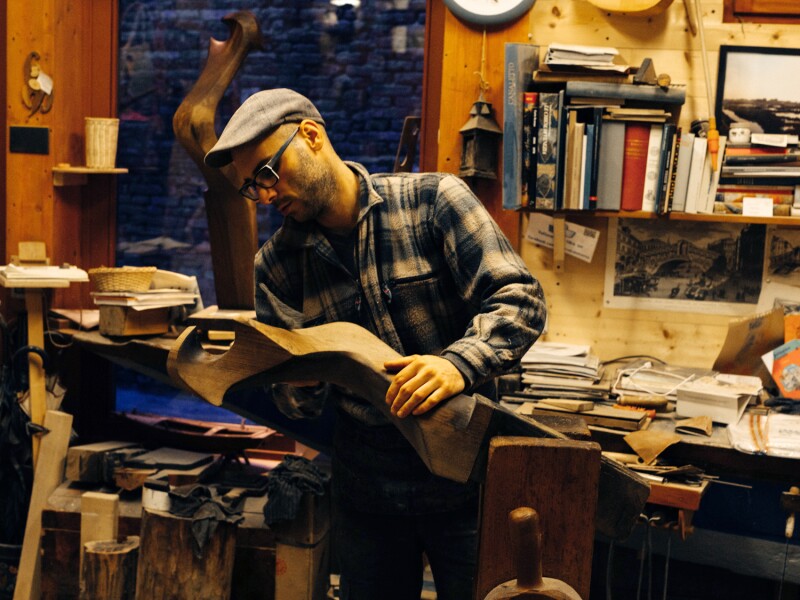“Be a traveler, not a tourist,” many Venetians urge. The kind of visitors Venetians welcome—and need—are those who stay for a while and support local businesses, crafts, and communities. Below is our guide to help you see Venice thoughtfully and responsibly.
Stay for more than a day
Longer stays help sustainable tourism because they contribute more vitally to all sectors of the city’s economy. Look for an apartment in neighborhoods such as Castello, San Polo, or Cannaregio through a socially responsible boutique agency such as Truly Venice, which also recommends local craftspeople and restaurants. Or consider a Venetian-owned hotel, whether it’s the grand Bauer Palazzo—where the toiletries are locally made—or the charming Hotel Flora, whose owners publish the excellent online guide Inside Venice.
They have also recently opened Casa Flora, a design-centric three-bedroom apartment that offers Venetian experiences, from rowing to cooking. On the color-splashed Burano Island, the family behind the visionary Venissa winery and hotel recently opened Casa Burano, a “diffuse hotel” that occupies five restored former fishermen and lace-makers’ houses. Among Casa Burano’s immersive experiences: eco-centric lagoon tours in a traditional bragozzo boat.
Support crafts
In addition to Il Forcolaio Matto, Paper Owl, and Antica Drogheria Mascari, mentioned in the story, find other proudly Venetian spots through Venezia Autentica. Cofounder Valeria Duflot also recommends the sleek Rialto atelier of Stefano and Daniele Attombri, who use a centuries-old perline bead technique to craft strikingly avant-garde jewelry. At her 1969 shop near Piazza San Marco the opinionated milliner Giuliana Longo will fit you with a perfect panama hat or beret and treat you to a lecture on the history of the three-cornered Carnevale hat.
Gondolier’s slippers called furlane get a modern, stylish handcrafted treatment in eye-popping shades at Piedàterre.
At Rugadoro (Ruga Rialto, 1035, San Polo), Sarah Zanarella uses Murano glass pieces, precious fabrics, feathers, and colorful patterns for her whimsical interpretations of Venetian Carnevale masks.

At Il Forcolaio Matto, Piero Dri creates rowing oars as the youngest of the four surviving forcolai in the city.
Photo by Robbie Lawrence
Eat and drink local
Young Venetians flock to the spots I visited—Ristorante Local and Osteria al Cicheto—and also to Vino Vero (Fondamenta Misericordia, 2497) for its blackboard list of mostly natural wines, creative cicchetti, and a resolutely local scene on Fondamenta della Misericordia—Venice’s current stand-in for Brooklyn. Locals also crowd Estro the cozy new-wave osteria in Dorsoduro serving artful tramezzini (finger sandwiches) by day, terroir-driven wines and a menu del mercato come evening.
The city’s restaurant royalty, the Alajmo brothers—the force behind the three-star Le Calandre outside Padua—didn’t stop with a sumptuous restoration of the 18th-century Ristorante Quadri, their million-dollar gift to the city. They’ve now opened the wittily swank Philippe Starck-designed Amo inside the historic department store Fondaco dei Tedeschi, featuring a creative-casual all-day menu and Italy’s best breakfast cornetti. Hipster mixology—craft cocktails involving artichoke sprouts or musk rose—also draws stylish young Venetians to the swish Il Mercante inside a former historic café in San Polo.
Classics? Join the morning neighborhood crowd for flutes of prosecco and meticulously assembled crostini at the tiny osteria All’Arco (San Polo, 436) near the Rialto; or lunch on generous plates of fritto misto and seafood lasagna among Venetian workers and students at Cannaregio’s old-school Trattoria dalla Marisa (Fondamenta di S. Giobbe, 652b).
Get off the beaten track
While day-trippers mob the area from Rialto to Piazza San Marco, you’ll find yourself almost alone with some of Venice’s most breathtaking art at its scuole (former charitable and religious organizations, some dating back to the 13th century), such as La Scuola Grande dei Carmini, with a glorious Tiepolo ceiling, and Scuola di San Giorgio degli Schiavoni, which features brilliant Carpaccios.
Another great way to shake the hordes and see even more glorious Venetian painting is to buy the Chorus Pass, which grants you access to 18 churches scattered all over the city. These include San Sebastiano in Dorsoduro, with its freshly restored Veroneses, and the grand Santissimo Redentore on Giudecca, designed by 16th-century master architect Palladio. If you’re into design, the Olivetti Showroom by midcentury architectural maestro Carlo Scarpa is on Piazza San Marco but off most tourist radars; ditto the modern garden Scarpa designed for the Fondazione Querini Stampalia, another small museum gem in Castello.
For truly Venetian experiences, book a voga rowing class through Row Venice; a mask-decorating or bookbinding session through Venezia Autentica; or a walking tour of hidden neighborhood corners from the passionate, erudite guide Luisella Romeo.
>>Next: Are We Loving Venice to Death?








